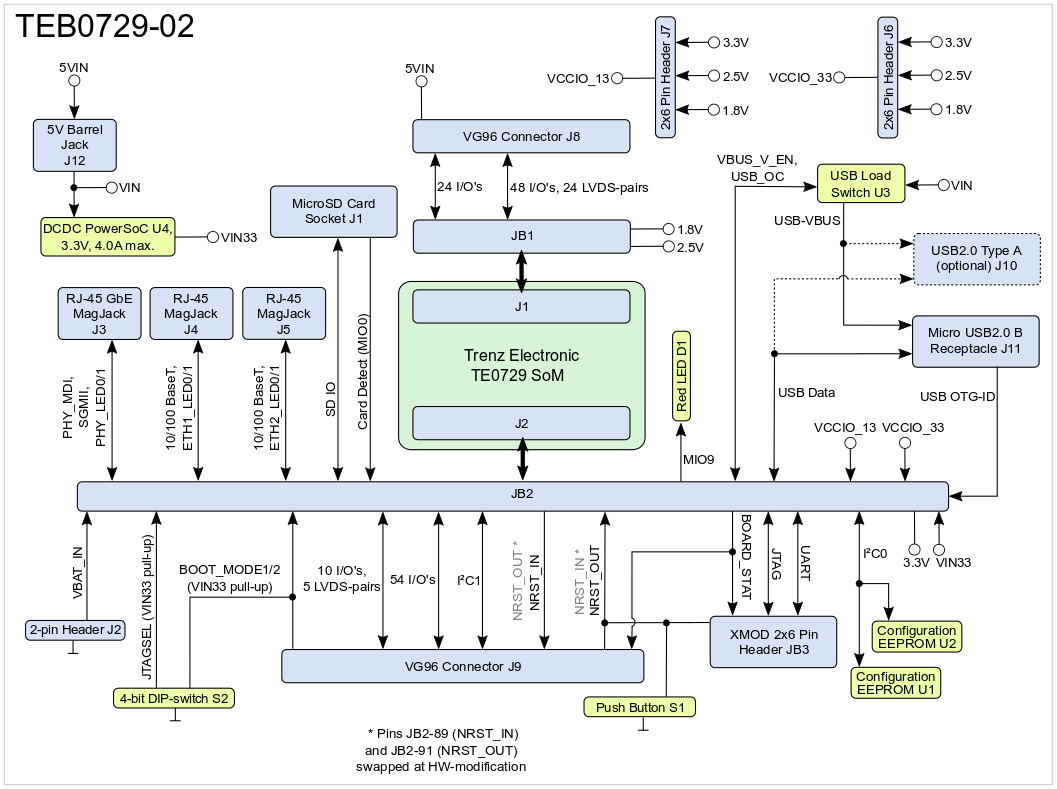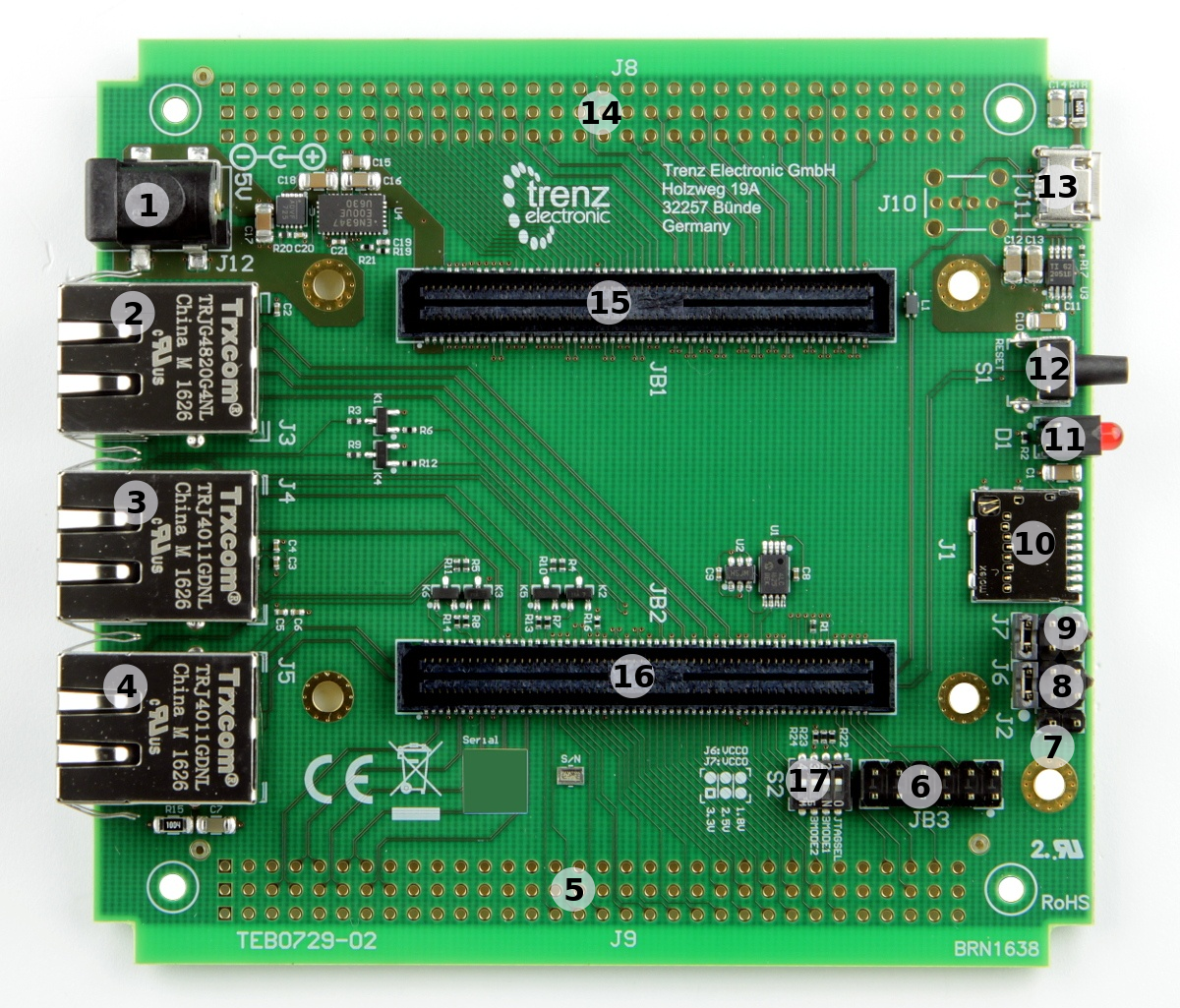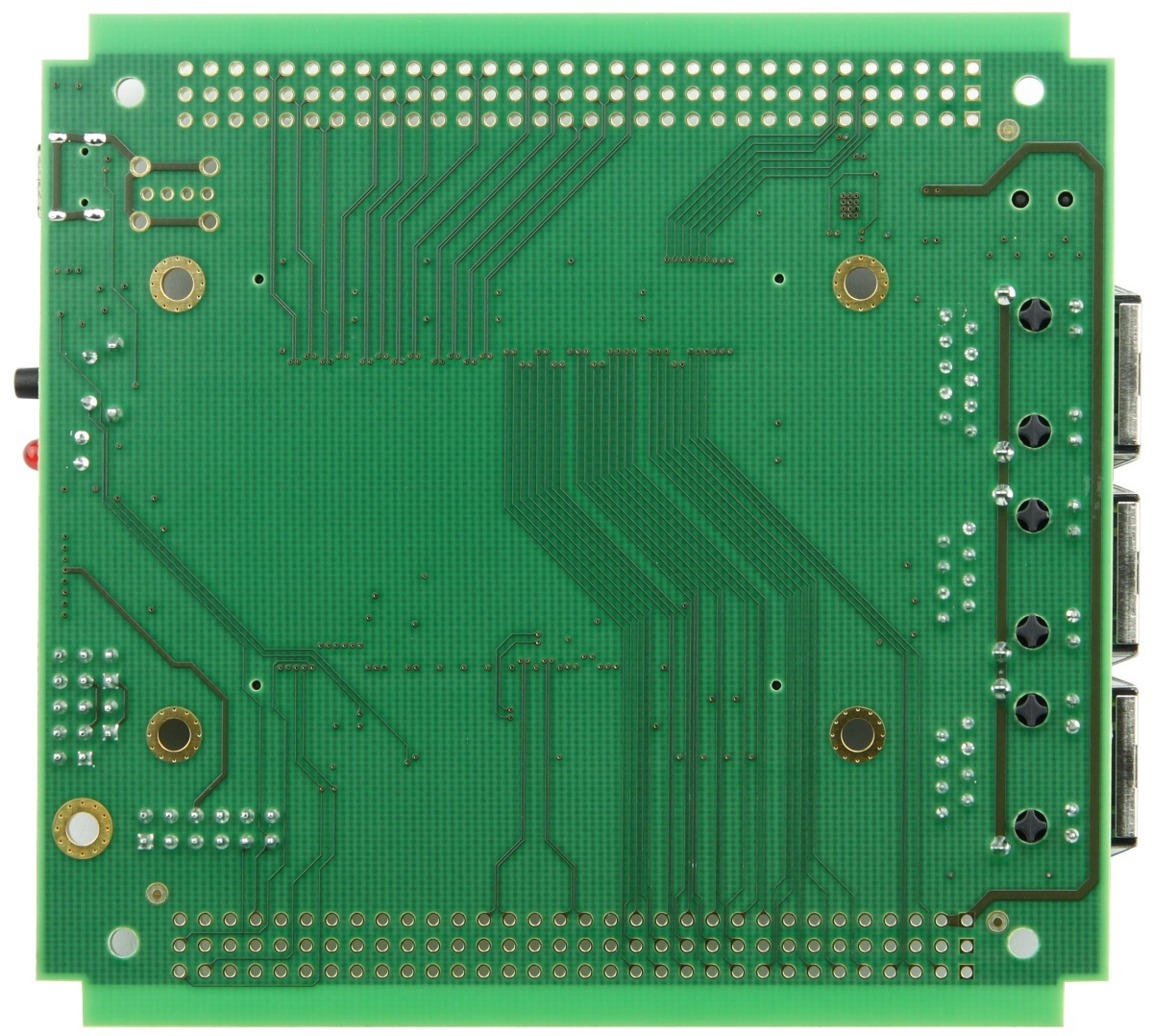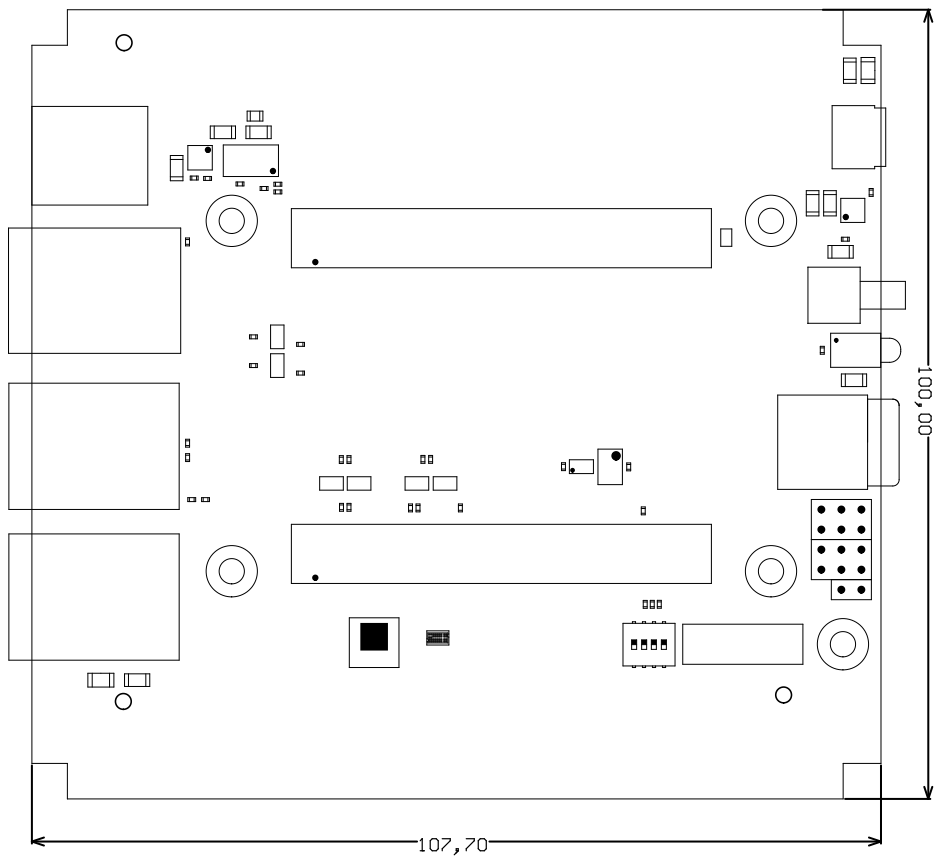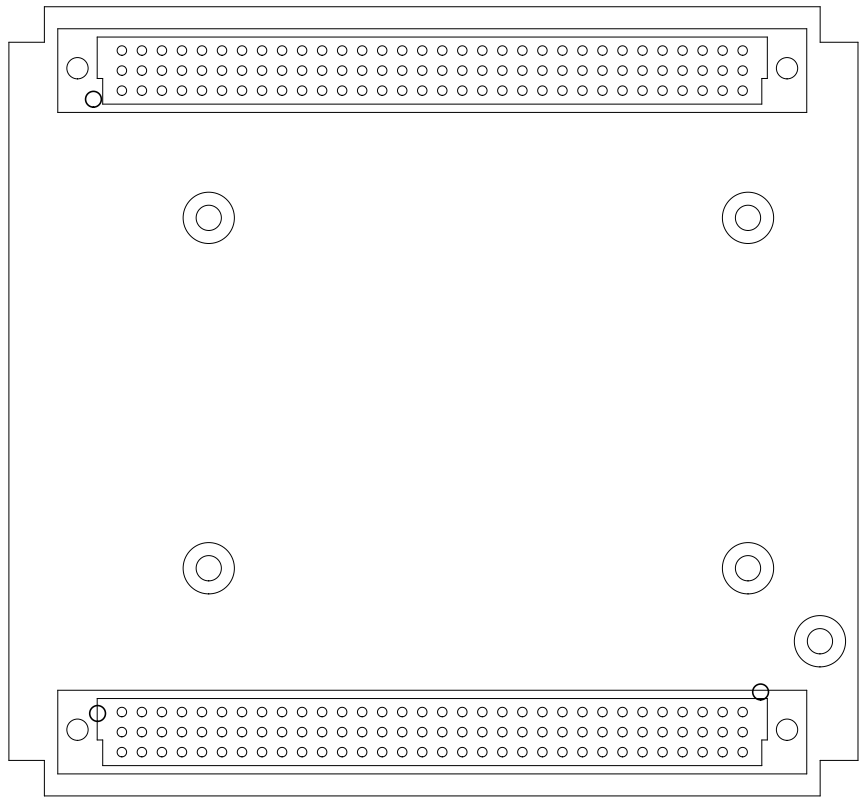Download PDF version of this document.
Table of Contents
Overview
The Trenz Electronic TEB0729 is a Carrier Board designed especially for the TE0729 Zynq-7000 SoM. The board exposes the module's B2B connector pins to accessible connectors and provides on-board peripheral components to test and evaluate TE Zynq-7000 SoMs and for developing purposes..
The Carrier Board provides soldering-pads for VG96 connectors as place-holders to get access to the PL-IO-banks and other functional units of the mounted SoM.
Key Features
- Barrel jack for 5V power supply
- 2x RJ45 10/100-BaseT Ethernet MagJack with 2 integrated LEDs
- 1x RJ45 Gigabit Ethernet MagJack with 2 integrated LEDs.
- 2x Configuration EEPROM's, connected to SoM's I²C interface
- XMOD compatible header to connect the TE0790 USB2.0 adapter board
- JTAG and UART interface over XMOD header
- MicroSD Card socket, can be used to boot system
- Micro-USB socket connected to Zynq module (device, host or OTG modes)
- 4-bit DIP switch for SoM configuration (SoM's JTAG access and Bootmode)
- VG96 connector soldering-pads J8 for access to SoM's PL-IO-bank-pins, usable as LVDS-pairs
- VG96 connector soldering-pads J9 for access to further interfaces and IO's of the SoM
- 1 x user LED (red) routed to SoM IO-pin
- 1 x user push-button routed to SoM (Reset function at standard configuration)
- Pin headers to set PL-IO-bank's VCCIO
- Pin header for supplying SoM's VBAT voltage
- Footprint for optional USB2.0 Type A socket
Additional assembly options are available for cost or performance optimization upon request.
Block Diagram
Figure 1: TEB0729-02 block diagram.
Main Components
Figure 2: TEB0729-02 main components.
- 5V barrel jack, J12
- RJ-45 Gigabit Ethernet MegJack, J3
- RJ-45 10/100-BaseT Ethernet MegJack, J4
- RJ-45 10/100-BaseT Ethernet MegJack, J5
- VG96 connector placeholder, J9
- XMOD (TE0790) header, JB3
- 2-pin header for VBAT-IN supply-voltage, J2
- 2x6 pin header for setting VCCIO_33, J6
- 2x6 pin header for setting VCCIO_13, J7
- MicroSD Card socket, J1
- Red LED, D1
- Push Button, S1
- Micro USB2.0 B Receptacle
- VG96 connector placeholder, J8
- B2B Connector, JB1
- B2B Connector, JB2
- 4-bit DIP-switch, S2
Initial Delivery State
Storage device name | Content | Notes |
|---|---|---|
| Configuration EEPROM, U1 | Empty | Not programmed |
| Configuration EEPROM, U2 | Empty | Not programmed |
Table 1: Initial delivery state of programmable devices on the module.
Signals, Interfaces and Pins
B2B Connector
The TEB0729 Carrier Board's Board-to-Board Connectors (B2B) have the same pin-assignment as the mounted Zynq SoM due to its hermaphroditic structure. By this connectors, the MIO- and PL-IO-bank's pins and further interfaces of the Zynq SoM can be accessed. A large quantity of these I/O's are also usable as LVDS-pairs. The connectors provide also VCCIO voltages to operate the I/O's properly.
Following table gives a summary of the available I/O's, interfaces and LVDS-pairs of the B2B connectors JB1 and JB2:
| VG96 Connector Designator | Count of IO's | Count of LVDS-pairs | Available VCCIO's | Interfaces | Notes |
|---|---|---|---|---|---|
| JB1 | 72 | 48 | 1.8V, 2.5V | - | - |
| JB2 | 64 | 5 | VCCIO_13, VCCIO_33 3.3V | I²C, | The 5 LVDS-pairs on connector JB2 have The I²C, SD IO and the UART interface pins are connected |
Table 2: General overview of PL I/O signals and SoM's interfaces connected to the B2B connectors.
VG96 Connector
The TEB0729 Carrier Board has soldering pads provides as place-holders to mount VG96 connectors J8 and J9 to get access the PL-IO-bank's pins and further interfaces of the Zynq SoM. With mounted VG96 connectors, SoM's IO's are available to the user, a large quantity of these I/O's are also usable as LVDS-pairs.
On the VG96 connector J9 are signals assigned to control the SoM and the interfaces of the SoM's Zynq chip and of its on-module peripherals:
Following table gives a summary of the pin-assignment, available interfaces and functional IO's of the VG96 connectors J8 and J9:
| VG96 Connector | Count of IO's | Count of LVDS-pairs | Interfaces | SoM Control Signals | Notes |
|---|---|---|---|---|---|
| J8 | 72 | 48 | - | - | - |
| J9 | 64 | 5 | I²C | 'NRST_IN', pin J9-A29 | Drive to ground (Push Button S1, JB3-11 (G) on XMOD header) to reset the SoM. 1) |
| 'NRST_OUT', pin J9-B30 | Incoming reset signal from SoM's watchdog (implemented on SoM's SC CPLD). 1) | ||||
| 'BOARD_STAT', pin J9-B32 | Frequently flipping signal indicating running SoM. Routed also to XMOD Header, pin JB3-9 (E). | ||||
| 'BOOT_MODE1', pin J9-C31 | Bootmode pin 1, use in conjunction with Bootmode pin 2. | ||||
| 'BOOT_MODE2', pin J9-C32 | Bootmode pin 2, use in conjunction with Bootmode pin 1. |
Table 3: General overview of PL I/O signals, SoM's interfaces and control signals connected to the VG96 connectors.
1) Use TE0729 SC CPLD firmware 'SC729_rev02org.jed' for correct functionality with HW modification.
JTAG Interface
JTAG access to the mounted SoM is provided through B2B connector JB2 and is also routed to the XMOD header JB3. With the TE0790 XMOD USB2.0 to JTAG adapter, the Zynq chip on the mounted SoM can be programed via USB2.0 interface.
JTAG Signal | B2B Connector Pin | XMOD Header JB3 | Note |
|---|---|---|---|
| TCK | JB2-119 | JB3-4 | - |
| TDI | JB2-115 | JB3-10 | - |
| TDO | JB2-117 | JB3-8 | - |
| TMS | JB2-113 | JB3-12 | - |
| JTAGSEL | JB2-111 | - | Select SoM's programming mode on DIP-switch S2-1. |
Table 4: JTAG interface signals.
UART Interface
UART interface is available on B2B connector JB2. With the TE0790 XMOD USB2.0 adapter, the UART signals can be converted to USB2.0 interface signals:
| UART Signal Schematic Name | B2B | XMOD Header JB3 | Note |
|---|---|---|---|
| USART0_RX | JB2-94 | JB3-7 | UART receive line |
| USART0_TX | JB2-96 | JB3-3 | UART transmit line |
Table 5: UART interface signals.
I²C Interface
Two I²C interfaces are provided on B2B connector JB2. I²C0 interface is connected to the Configuration EEPROMs U1 and U2 and is dedicated to these on-board peripherals. Interface I²C1 is routed to the VG96 connector J9 and is available to the user for general purposes:
| I²C Signal Schematic Name | B2B | Connected to | Note |
|---|---|---|---|
| I2C0_SDA | JB2-90 | EEPROMs U1, U2 | I²C data line |
| I2C0_SCL | JB2-92 | EEPROMs U1, U2 | I²C clock line |
| I2C1_SDA | JB2-93 | J9-A30 | I²C data line |
| I2C1_SCL | JB2-95 | J9-A31 | I²C clock line |
Table 6: I²C interface signals.
SD IO Interface
The SD IO interface of the SoM's Zynq chip (MIO-bank) is routed to the on-board MicroSD Card socket J1. By this interface, the Zynq chip can be booted from an inserted MicroSD Card:
| SD IO Signal Schematic Name | B2B | Connected to | Note |
|---|---|---|---|
| ESD_DAT0 | JB2-108 | J1-7 | SD IO data |
| ESD_DAT1 | JB2-110 | J1-8 | SD IO data |
| ESD_DAT2 | JB2-100 | J1-1 | SD IO data |
| ESD_DAT3 | JB2-102 | J1-2 | SD IO data |
| ESD_CLK | JB2-106 | J1-5 | SD IO clock |
| ESD_CMD | JB2-104 | J1-3 | SD IO command |
| MIO0 | JB2-87 | J1-9 | Card Detect signal |
Table 7: SD IO interface signals.
USB2.0 Interface
The TEB0729 Carrier Board is equipped with a Micro USB2.0 B (receptacle) socket J11. The differential data signals of the socket J11 are routed to the B2B connector JB2, where they can be accessed by the USB2.0 transceiver of the mounted SoM. The Micro USB connector can be used for Device mode, OTG Mode or Host Modes. For USB Host mode, the Carrier Board is additionally equipped with an USB load switch U3 to provide the USB interface with the USB supply voltage USB-VBUS with nominal value of 5V.
The Carrier Board provides the footprints J10 to equip the board with an USB2.0 Type A socket as an option (OTG mode is not available with USB2.0 Type A socket).
Following table gives an overview of the USB2.0 interface signals:
| USB2.0 Signal Schematic Name | B2B | Connected to | Note |
|---|---|---|---|
| OTG-D_N | JB2-103 | J11-2, (J10-2) | USB2.0 data |
| OTG-D_P | JB2-101 | J11-3, (J10-3) | USB2.0 data |
| OTG-ID | JB2-109 | J11-4 | Ground this pin for A-Device (host), left floating this pin for B-Device (peripheral). |
| VBUS_V_EN | JB2-97 | U3, pin 4 | Enable USB-VBUS. |
| USB-VBUS | JB2-107 | J11-1, (J10-1) | USB supply voltage in Host mode. |
| USB_OC | JB2-48, J9-B29 | U3, pin 5 | USB-VBUS over current signal: current-limit threshold exceeded by the connected USB device in USB Host mode. |
Table 8: USB2.0 interface signals and connections.
Gigabit Ethernet Interface
The TEB0729 Carrier Board is fitted with one RJ-45 Gigabit Ethernet Magnetic jack J3. The MegJack has two integrated LEDs (both green), its signals are routed as MDI (Media Dependent Interface) to the B2B connector JB2, where they can be accessed by the GbE PHY transceiver of the mounted SoM:
| GbE PHY Signal Schematic Name | B2B | Connected to | Notes |
|---|---|---|---|
| PHY_MDI0_P | JB2-84 | J3-2 | - |
| PHY_MDI0_N | JB2-82 | J3-3 | - |
| PHY_MDI1_P | JB2-78 | J3-4 | - |
| PHY_MDI1_N | JB2-76 | J3-5 | - |
| PHY_MDI2_P | JB2-72 | J3-6 | - |
| PHY_MDI2_N | JB2-70 | J3-7 | - |
| PHY_MDI3_P | JB2-66 | J3-8 | - |
| PHY_MDI3_N | JB2-64 | J3-9 | - |
| PHY_LED0 | JB2-59 | Green MegJack J3 LED | - |
| PHY_LED1 | JB2-57 | Green MegJack J3 LED | - |
Table 9: GbE interface signals and connections.
For the same GbE transceiver PHY on the mounted SoM, on the Carrier Board is also a SGMII (Serial Gigabit Media Independent Interface) available. The SGMII pins are available on VG96 connector:
| GbE PHY Signal Schematic Name | B2B | Connected to | Notes |
|---|---|---|---|
| SIN_P | JB2-52 | J9-A16 | - |
| SIN_N | JB2-54 | J9-A17 | - |
| SOUT_P | JB2-58 | J9-A19 | - |
| SOUT_N | JB2-60 | J9-A20 | - |
Table 10: GbE SGMII signals and connections.
10/100-BaseT Ethernet Interface
The TEB0729 Carrier Board is also fitted with two additional RJ-45 MegJacks providing 10/100-BaseT Ethernet interfaces. This interfaces are routed to the B2B connector JB2
| 10/100-BaseT PHY Signal Schematic Name | B2B | Connected to | Notes |
|---|---|---|---|
| ETH1_RX_P | JB2-26 | J4-3 | - |
| ETH1_RX_N | JB2-28 | J4-6 | - |
| ETH1_TX_P | JB2-20 | J4-1 | - |
| ETH1_TX_N | JB2-22 | J4-2 | - |
| ETH1_CTREF | JB2-30 | J4-4, J4-5 | Centre Tap Reference point |
| ETH1_LED0 | JB2-34 | Yellow MegJack J4 LED | - |
| ETH1_LED1 | JB2-32 | Green MegJack J4 LED | - |
| ETH2_RX_P | JB2-8 | J5-3 | - |
| ETH2_RX_N | JB2-10 | J5-6 | - |
| ETH2_TX_P | JB2-2 | J5-1 | - |
| ETH2_TX_N | JB2-4 | J5-2 | - |
| ETH2_CTREF | JB2-18 | J5-4, J5-5 | Centre Tap Reference point |
| ETH2_LED0 | JB2-16 | Yellow MegJack J5 LED | - |
| ETH2_LED1 | JB2-14 | Green MegJack J5 LED | - |
Table 11: 10/100-BaseT Ethernet interfaces signals and connections.
XMOD FTDI JTAG-Adapter Header
The JTAG interface of the mounted SoM can be accessed via header JB3, which has a 'XMOD FTDI JTAG Adapter'-compatible pin-assignment. So in use with the XMOD-FT2232H adapter-board TE0790 the mounted SoM can be programmed via USB interface. The TE0790 board provides also an UART interface to the Zynq SoM which can be accessed by the USB2.0 interface of the adapter-board while the signals between these serial interfaces will be converted. The adapter-board offers also two GPIO's, one with an indication LED (pin JB3-9 (E)) and another one with a low-active push button (pin JB3-11 (G)).
Following table describes the signals and interfaces of the XMOD header JB3:
| JB3 pin | Signal Schematic Net Name | B2B | Note |
|---|---|---|---|
| C (pin 4) | TCK | JB2-119 | - |
| D (pin 8) | TDO | JB2-117 | - |
| F (pin 10) | TDI | JB2-115 | - |
| H (pin 12) | TMS | JB2-113 | - |
| A (pin 3) | USART0_TX | JB2-96 | - |
| B (pin 7) | USART0_RX | JB2-94 | - |
| E (pin 9) | BOARD_STAT | JB2-112 | also connected to VG96 connector pin J9-B32 |
| G (pin 11) | NRST_IN | JB2-89 | also connected to VG96 connector pin J9-A29 |
Table 12: XMOD header signals and connections.
When using XMOD FTDI JTAG Adapter TE0790, set the DIP-switch with the setting:
- S2-1: ON
- S2-2: OFF
- S2-3: OFF
- S2-4: ON
By this setting, the adapter-board's VCC and VCCIO will be completely sourced by the Carrier Board.
On-board Peripherals
Configuration EEPROM
The TEB0729 Carrier Board is equipped with two Configuration EEPROMs U1 and U2 from Microchip.
- U1: Microchip 24LC128: 128 KBit memory density (8 pages a 16 KBit), 400 KHz max. clock frequency
- I²C-Address: 1010 101
- U2: Microchip 24AA025E48T: 2 KBit memory density (2 block of 128 x 8-bit words), 400 KHz max. clock frequency
- I²C-Address: 1010 011
The Configuration EEPROMs are connected to the I²C0 interface of the Zynq's MIO-bank via B2B connector JB2.
4-bit DIP-switch
Table below describes DIP-switch S2 settings for configuration of the mounted SoM:
| DIP-switches S2 | Signal Schematic Net Name | Function | Note |
|---|---|---|---|
| S2-1 | JTAGSEL | Select Zynq chip or SC CPLD programming of mounted SoM on DIP-switch S2-1. OFF: Zynq chip programming. | Depends also on SoM's SC CPLD firmware configuration. |
| S2-2 | BOOT_MODE1 | Select first bit of Zynq chips bootmode code | Refer to TE0729 TRM for detailed information about boot modes. |
| S2-3 | BOOT_MODE2 | Select second bit of Zynq chips bootmode code | - |
| S2-4 | x | x | not used |
Table 13: DIP-Switch S2 SoM configuration settings.
VCCIO Setting Jumper
The Carrier Board VCCIO for the PL IO-banks of the mounted SoM are selectable by the jumpers J6 and J7.
Following table describes how to configure the VCCIO of the SoM's banks with jumpers:
| VCCIO vs. voltage levels | VCCIO_13 | VCCIO_33 | Note |
|---|---|---|---|
| 1.8V | J7: 1-2 | J6: 1-2 | - |
| 2.5V | J7: 3-4 | J6: 3-4 | - |
| 3.3V | J7: 5-6 | J6: 5-6 | - |
Table 14: VCCIO jumper settings.
RTC Buffer Voltage Supply Header
The buffer voltage of the SoM's RTC can be supplied through the header J2. Refer to the SoM's TRM for recommended voltage range and absolute maximum ratings.
Push Button
The Carrier Board's push button S1 is connected to the 'NRST_IN' signal of the mounted SoM. The function of the button is to trigger a reset of the mounted SoM by driving the reset-signal 'NRST_IN' to ground.
On-board LEDs
| LED | Color | Connected to | Description and Notes |
|---|---|---|---|
| D1 | Red | 'MIO9', JB2- 88 | user LED |
Table 15: On-board LEDs.
Power and Power-On Sequence
Power Consumption
The maximum power consumption of a module mainly depends on the design running on the FPGA.
Xilinx provide a power estimator excel sheets to calculate power consumption. It's also possible to evaluate the power consumption of the developed design with Vivado. See also Trenz Electronic Wiki FAQ.
| Power Input | Typical Current |
|---|---|
| 5VIN | TBD* |
Table 16: Typical power consumption.
* TBD - To Be Determined soon with reference design setup.
Power supply with minimum current capability of 3A for system startup is recommended.
Power Distribution Dependencies
Regulator dependencies and max. current.
Put power distribution diagram here...
Figure : Module power distribution diagram.
See Xilinx data sheet ... for additional information. User should also check related base board documentation when intending base board design for TE07xx module.
Power-On Sequence
The TE07xx SoM meets the recommended criteria to power up the Xilinx Zynq MPSoC properly by keeping a specific sequence of enabling the on-board DC-DC converters dedicated to the particular functional units of the Zynq chip and powering up the on-board voltages.
Following diagram clarifies the sequence of enabling the particular on-board voltages, which will power-up in descending order as listed in the blocks of the diagram:
Put power-on diagram here...
Figure : Module power-on diagram.
Power Rails
| Module Connector (B2B) Designator | VCC / VCCIO | Direction | Pins | Notes |
|---|---|---|---|---|
| JB1 | VIN33 | Out | Pin 1, 2, 3, 4, 5, 6 | 3.3V module supply voltage |
| VCCIO_13 | Out | Pin 101, 102 | PL IO-bank VCCIO | |
| VCCIO_33 | Out | Pin 29, 30 | PL IO-bank VCCIO | |
| 3.3V | In | Pin 65, 66 | voltage output from module | |
| JB2 | 1.8V | In | Pin 49 | voltage output from module |
| 2.5V | In | Pin 13 | voltage output from module | |
| USB-VBUS | Out | Pin 107 | USB Host supply voltage | |
| VBAT_IN | Out | Pin 118 | RTC buffer voltage |
Table 17: Power pin description of B2B Module Connector.
| Jumper / Header Designator | VCC / VCCIO | Direction | Pins | Notes |
|---|---|---|---|---|
| J6 | VCCIO_33 | Out | Pin 2, 4, 6 | - |
| 1.8V | In | 5 | - | |
| 2.5V | In | 3 | - | |
| 3.3V | In | 1 | - | |
| J7 | VCCIO_13 | Out | Pin 2, 4, 6 | - |
| 1.8V | In | 5 | - | |
| 2.5V | In | 3 | - | |
| 3.3V | In | 1 | - |
Table 18: Power Pin description of VCCIO selection jumper pin header.
| Main Power Jack and Pins Designator | VCC / VCCIO | Direction | Pins | Notes |
|---|---|---|---|---|
| J12 | 5VIN | In | - | - |
| J9 | 5VIN | In | Pin A1, A2 | '5VIN' power supply to the Carrier Board as alternative to J12 |
Table 19: Main Power jack and pins description.
| Peripheral Socket Designator | VCC / VCCIO | Direction | Pins | Notes |
|---|---|---|---|---|
| J10 | USB-VBUS | Out | Pin 1 | - |
| J11 | USB-VBUS | Out | Pin 1 | - |
| J1 | VIN33 | Out | Pin 4 | MikroSD Card socket VDD |
Table 20: Power pin description of peripheral connector.
| XMOD Header Designator | VCC / VCCIO | Direction | Pins | Notes |
|---|---|---|---|---|
| JB3 | 3.3V | - | Pin 5 | not connected |
| VIO | In | Pin 6 | connected to VIN33 |
Table 21: Power pin description of XMOD/JTAG Connector.
Board to Board Connectors
Variants Currently In Production
NB! Note that here we look at the module as a whole, so you just can't rely only on junction temperature or max voltage of particular SoC or FPGA chip on the module. See examples in the table below.
| Module Variant | FPGA / SoC | Operating Temperature | Temperature Range |
|---|---|---|---|
| TE0710-02-35-2CF | XC7A35T-2CSG324C | 0°C to +70°C | Commercial |
| TE0715-04-30-3E | XC7Z030-3SBG485E | 0°C to +85°C | Extended |
| TE0841-01-035-1I | XCKU035-1SFVA784I | –40°C to +85°C | Industrial |
| .. | .. | .. | .. |
Table : Module variants.
Technical Specifications
Absolute Maximum Ratings
Parameter | Min | Max | Units | Reference Document |
|---|---|---|---|---|
VIN supply voltage | V | - | ||
Storage temperature |
| °C | - |
Table : Module absolute maximum ratings.
Recommended Operating Conditions
| Parameter | Min | Max | Units | Reference Document |
|---|---|---|---|---|
| VIN supply voltage | ||||
| Operating temperature |
Table : Module recommended operating conditions.
Operating Temperature Ranges
Commercial grade: 0°C to +70°C.
Extended grade: 0°C to +85°C.
Industrial grade: -40°C to +85°C.
Module operating temperature range depends also on customer design and cooling solution. Please contact us for options.
Physical Dimensions
Board size: 107.70 mm × 100 mm. Please download the assembly diagram for exact numbers.
Mating height with standard connectors: ... mm.
PCB thickness: ... mm.
Highest part on PCB: approx. ... mm. Please download the step model for exact numbers.
All dimensions are given in millimeters.
Figure : Board physical dimensions drawing.
Revision History
Hardware Revision History
| Date | Revision | Notes | PCN | Documentation Link |
|---|---|---|---|---|
| - | 01 | Prototypes | ||
Table : Module hardware revision history.
Hardware revision number can be found on the PCB board together with the module model number separated by the dash.
Put picture of actual PCB showing model and hardware revision number here...
Figure : Module hardware revision number.
Document Change History
Date | Revision | Contributors | Description |
|---|---|---|---|
| Ali Naseri | initial document |
Table : Document change history.
Disclaimer
Data Privacy
Please also note our data protection declaration at https://www.trenz-electronic.de/en/Data-protection-Privacy
Document Warranty
The material contained in this document is provided “as is” and is subject to being changed at any time without notice. Trenz Electronic does not warrant the accuracy and completeness of the materials in this document. Further, to the maximum extent permitted by applicable law, Trenz Electronic disclaims all warranties, either express or implied, with regard to this document and any information contained herein, including but not limited to the implied warranties of merchantability, fitness for a particular purpose or non infringement of intellectual property. Trenz Electronic shall not be liable for errors or for incidental or consequential damages in connection with the furnishing, use, or performance of this document or of any information contained herein.
Limitation of Liability
In no event will Trenz Electronic, its suppliers, or other third parties mentioned in this document be liable for any damages whatsoever (including, without limitation, those resulting from lost profits, lost data or business interruption) arising out of the use, inability to use, or the results of use of this document, any documents linked to this document, or the materials or information contained at any or all such documents. If your use of the materials or information from this document results in the need for servicing, repair or correction of equipment or data, you assume all costs thereof.
Copyright Notice
No part of this manual may be reproduced in any form or by any means (including electronic storage and retrieval or translation into a foreign language) without prior agreement and written consent from Trenz Electronic.
Technology Licenses
The hardware / firmware / software described in this document are furnished under a license and may be used /modified / copied only in accordance with the terms of such license.
Environmental Protection
To confront directly with the responsibility toward the environment, the global community and eventually also oneself. Such a resolution should be integral part not only of everybody's life. Also enterprises shall be conscious of their social responsibility and contribute to the preservation of our common living space. That is why Trenz Electronic invests in the protection of our Environment.
REACH, RoHS and WEEE
REACH
Trenz Electronic is a manufacturer and a distributor of electronic products. It is therefore a so called downstream user in the sense of REACH. The products we supply to you are solely non-chemical products (goods). Moreover and under normal and reasonably foreseeable circumstances of application, the goods supplied to you shall not release any substance. For that, Trenz Electronic is obliged to neither register nor to provide safety data sheet. According to present knowledge and to best of our knowledge, no SVHC (Substances of Very High Concern) on the Candidate List are contained in our products. Furthermore, we will immediately and unsolicited inform our customers in compliance with REACH - Article 33 if any substance present in our goods (above a concentration of 0,1 % weight by weight) will be classified as SVHC by the European Chemicals Agency (ECHA).
RoHS
Trenz Electronic GmbH herewith declares that all its products are developed, manufactured and distributed RoHS compliant.
WEEE
Information for users within the European Union in accordance with Directive 2002/96/EC of the European Parliament and of the Council of 27 January 2003 on waste electrical and electronic equipment (WEEE).
Users of electrical and electronic equipment in private households are required not to dispose of waste electrical and electronic equipment as unsorted municipal waste and to collect such waste electrical and electronic equipment separately. By the 13 August 2005, Member States shall have ensured that systems are set up allowing final holders and distributors to return waste electrical and electronic equipment at least free of charge. Member States shall ensure the availability and accessibility of the necessary collection facilities. Separate collection is the precondition to ensure specific treatment and recycling of waste electrical and electronic equipment and is necessary to achieve the chosen level of protection of human health and the environment in the European Union. Consumers have to actively contribute to the success of such collection and the return of waste electrical and electronic equipment. Presence of hazardous substances in electrical and electronic equipment results in potential effects on the environment and human health. The symbol consisting of the crossed-out wheeled bin indicates separate collection for waste electrical and electronic equipment.
Trenz Electronic is registered under WEEE-Reg.-Nr. DE97922676.
